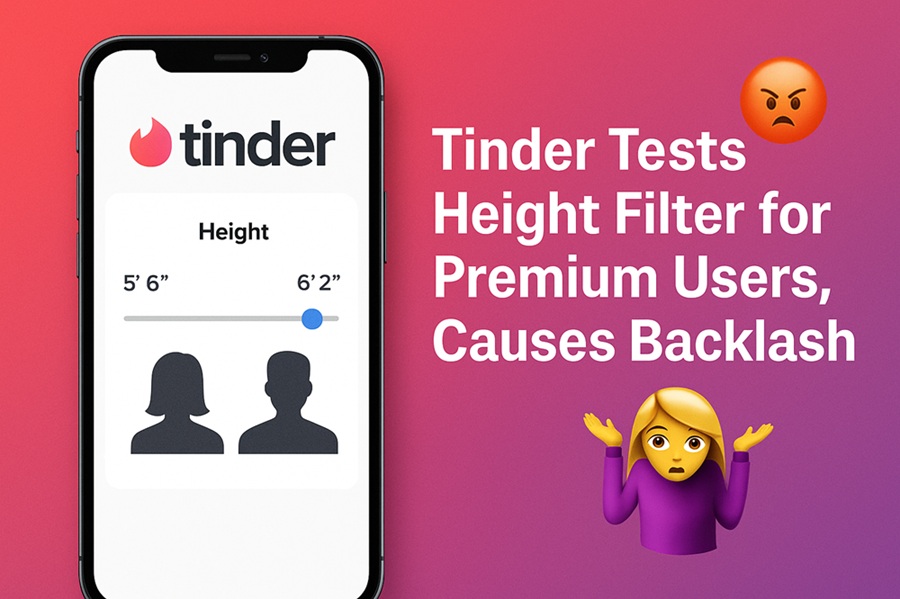Tinder, the globally popular dating app, is once again in the spotlight—this time for testing a height-based preference filter for its premium subscribers. While the company says the feature is intended to help users connect more intentionally, it has quickly become a lightning rod for debate across social media and news platforms.
The feature, currently available to a select group of Tinder Gold and Platinum users, allows them to set a minimum and maximum height range for potential matches. While Tinder maintains that this is a soft filter—not a strict exclusion criterion—it has triggered concerns about promoting superficial standards and reinforcing long-standing biases, especially against shorter men.
A New Direction for Tinder’s Premium Features
Over the past few years, Tinder has aggressively expanded its portfolio of paid features to compete with platforms like Hinge and Bumble. The company has introduced tools such as profile boosts, advanced search filters, and AI-powered suggestions—all targeted at users willing to pay a monthly fee.
The new height preference filter fits into this strategy. It aims to provide more precise control over match discovery for paying users. Unlike gender, location, or age filters, height is a more controversial metric, often tied to personal bias and cultural stereotypes.
According to industry observers, Tinder is likely testing whether such granular filters can improve match satisfaction and retention among premium users. However, this move appears to be a calculated risk—one that may pay off financially but damage the brand’s reputation.
Social Media Backlash: "It’s Over for Short Men"
The rollout of the feature has not gone unnoticed. Across social media platforms in the US, India, and Europe, reactions have ranged from humor to outrage. Critics argue that Tinder is formalizing what was previously an unspoken bias.
Phrases like “Short kings under attack” and “Discrimination behind a paywall” have been trending across X (formerly Twitter), Reddit, and Instagram. In India, where dating apps have only recently gained mainstream traction, several influencers and commentators questioned the ethical implications of monetizing physical attributes.
In the EU, where digital platforms are increasingly under regulatory scrutiny for discriminatory practices, the feature may face questions from data and consumer rights watchdogs.
Cultural and Social Implications
While user preferences are a valid part of dating, the question arises: Should platforms actively support preferences based on physical traits? Height, unlike personality, education, or lifestyle habits, is a trait people cannot control.
Experts argue that allowing filters for such attributes risks legitimizing exclusionary behavior and may even impact user self-esteem. Especially in countries like India and across Asia, where height is often linked to perceived attractiveness and social status, this could reinforce damaging stereotypes.
Dr. Rhea K., a sociologist based in Berlin, explained, “Digital platforms have a responsibility to not just respond to user demand, but to shape behavior ethically. Encouraging users to filter based on height—especially behind a paywall—sends the wrong message.”
Supporters Say: It's About Choice, Not Discrimination
Not everyone is critical. Some users have praised the new filter as a time-saving measure that aligns with personal preferences. In fact, height preferences are often already implied in bios or early conversations.
“I’d rather filter it out up front than waste time on incompatible expectations,” said a premium user in New York. Similar sentiments have been echoed by users in London and Mumbai, who see it as no different from filtering based on religion, political views, or smoking habits.
Tinder has not confirmed whether the feature will be rolled out globally or remain a limited test. A company spokesperson said, “We regularly test features to understand what improves the user experience. This filter is designed to give users more control while keeping their match pool broad.”
The Commercial Motive Behind the Filter
Tinder's parent company, Match Group, has increasingly leaned into subscription-based monetization, with features like "See Who Likes You" and "Top Picks" driving revenue growth. This new filter is yet another way to add perceived value to their premium tiers.
However, such features also signal a larger trend—the stratification of dating experiences based on who can afford more control. As dating apps evolve into digital marketplaces, users who pay more get better visibility, control, and access—raising questions about equity in online dating.
Where Do We Go From Here?
The debate over Tinder’s height filter touches on broader issues of ethics, personal preference, and platform responsibility. If dating apps continue to offer filters for physical attributes, will we eventually see filters for skin tone, body type, or income?
For users in the EU, where digital rights are increasingly protected under laws like the Digital Services Act, this could become a point of contention. In India and the US, where cultural conversations around inclusivity are evolving, platforms like Tinder will need to walk a fine line between personalization and prejudice.
Final Thoughts
Whether the height filter becomes a permanent feature or not, Tinder has opened a Pandora’s box. At a time when users are increasingly aware of social justice issues, such features—however well-intended—can appear tone-deaf. What Tinder does next may not only shape its business model but also influence how we define fairness and inclusivity in the digital age of dating.
